

Low Glycemic Load Diet. Type 1 Diabetes. Diabetes and Emotions - Coping with Diabetes. Blog: Top 10 diabetes myths. Video: How diabetes affects your blood sugar. Your body uses glucose for energy.

Glucose metabolism requires insulin, a hormone produced by your pancreas. Here's how normal glucose metabolism works, and what happens when you have diabetes — a disease where your body either can't produce enough insulin or it can't use insulin properly. The food you eat consists of three basic nutrients: carbohydrates, protein and fat. During digestion, chemicals in your stomach break down carbohydrates into glucose, which is absorbed into your bloodstream. Your pancreas responds to the glucose by releasing insulin. Calculators. Insulin Resistance – a treatable link with Alzheimer’s disease. Insulin Resistance and Pre-diabetes. On this page: What is insulin?
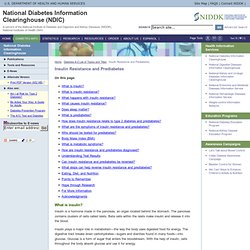
Insulin is a hormone made in the pancreas, an organ located behind the stomach. The pancreas contains clusters of cells called islets. Beta cells within the islets make insulin and release it into the blood. Insulin plays a major role in metabolism—the way the body uses digested food for energy. Insulin’s Role in Blood Glucose Control When blood glucose levels rise after a meal, the pancreas releases insulin into the blood. Insulin helps muscle, fat, and liver cells absorb glucose from the bloodstream, lowering blood glucose levels. Diabetes. Diagnosis of Diabetes. On this page: What is diabetes?
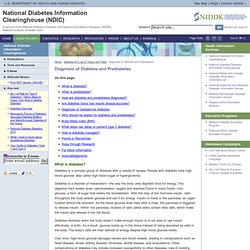
Diabetes is a complex group of diseases with a variety of causes. People with diabetes have high blood glucose, also called high blood sugar or hyperglycemia. Diabetes is a disorder of metabolism—the way the body uses digested food for energy. The digestive tract breaks down carbohydrates—sugars and starches found in many foods—into glucose, a form of sugar that enters the bloodstream. Insulin Resistance Explained.
Have you heard the terms insulin resistance, insulin sensitivity and metabolic syndrome in the same breath as prediabetes and type 2 diabetes?
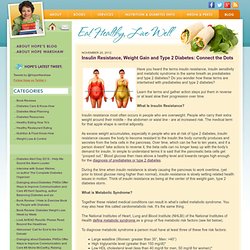
Do you wonder how these terms are intertwined with prediabetes and type 2 diabetes? Learn the terms and gather action steps put them in reverse or at least slow their progression over time. What Is Metabolic Syndrome? Metabolic (met-ah-BOL-ik) syndrome is the name for a group of risk factors that raises your risk for heart disease and other health problems, such as diabetes and stroke.
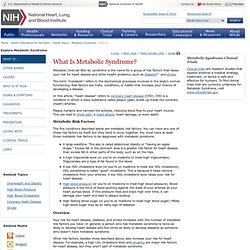
The term "metabolic" refers to the biochemical processes involved in the body's normal functioning. Risk factors are traits, conditions, or habits that increase your chance of developing a disease. In this article, "heart disease" refers to coronary heart disease (CHD). CHD is a condition in which a waxy substance called plaque (plak) builds up inside the coronary (heart) arteries. Plaque hardens and narrows the arteries, reducing blood flow to your heart muscle. Metabolic Risk Factors The five conditions described below are metabolic risk factors.
Natural Treatments for Type 2 Diabetes. What is Type 2 Diabetes?
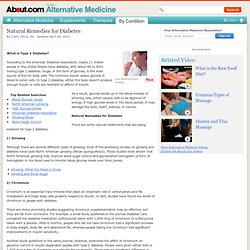
According to the American Diabetes Association, nearly 21 million people in the United States have diabetes, with about 90 to 95% having type 2 diabetes. Sugar, in the form of glucose, is the main source of fuel for body cells. The hormone insulin allows glucose in blood to enter cells. More Magnesium Means Less Diabetes. Natural Remedies for Diabetes. Diabetes Can Be Reversed Through Major Diet and Lifestyle Changes. By Mike Adam, Natural News A recent report (February 07, 2011) by CNN says that improving one's diet, keeping off excess weight, and regularly exercising, can help millions of people with diabetes get rid of it for good.
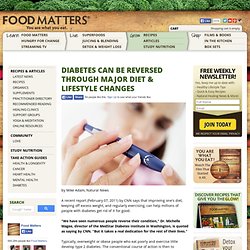
"We have seen numerous people reverse their condition," Dr. Michelle Magee, director of the MedStar Diabetes Institute in Washington, is quoted as saying by CNN. "But it takes a real dedication for the rest of their lives. " Search results for Diabetes. Medical News in Diabetes. Thiamine 'reverses kidney damage' Doses of vitamin B1 (thiamine) can reverse early kidney disease in people with type 2 diabetes, research shows.
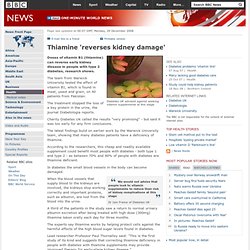
The team from Warwick University tested the effect of vitamin B1, which is found in meat, yeast and grain, on 40 patients from Pakistan. The treatment stopped the loss of a key protein in the urine, the journal Diabetologia reports. Charity Diabetes UK called the results "very promising" - but said it was too early for any firm conclusions. The latest findings build on earlier work by the Warwick University team, showing that many diabetes patients have a deficiency of thiamine.
DiabetesAndDiet. Diabetes in Depth. In-depth Complications Amputation and diabetes If you have diabetes, here's what you need to know about foot care and preventing serious complications that often require amputation.

Managing Your Diabetes Head to Toe, a Tool from WebMD. Assessing Your Weight: Body Mass Index (BMI) Body Mass Index Chart.
Carbs - What you need to know. Diabetes Health - Investigate, Inform, Inspire. 10 Questions to Ask Your Doctor. Diabetic Food Shopping List. Taking Insulin? Avoid Getting Fat! « Dr. Sheri's Blog. Life Extension Diets. Create Your Plate. Create Your Plate is a simple and effective way to manage your blood glucosethe main sugar found in the blood and the body's main source of energy.
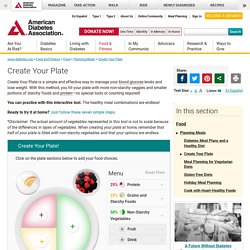
Also called blood sugar.X levels and lose weight. With this method, you fill your plate with more non-starchy veggies and smaller portions of starchy foods and protein1. One of the three main nutrients in food. Foods that provide protein include meat, poultry, fish, cheese, milk, dairy products, eggs, and dried beans. 2. Proteins are also used in the body for cell structure, hormones such as insulin, and other functions.X—no special tools or counting required! You can practice with this interactive tool. Ready to try it at home? *Disclaimer: The actual amount of vegetables represented in this tool is not to scale because of the differences in types of vegetables. The Diabetes Quiz.
Diabetic Risks. Diabetic Food Cures. Diabetes & Exercise.